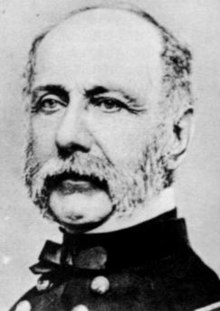James Barnes (General)
James Barnes (born December 28, 1801 in Boston , Massachusetts , † February 12, 1869 in Springfield , Massachusetts) was an American railroad manager and a Union general during the American Civil War .
Before the civil war
Barnes attended the Boston Latin School and then graduated in 1829 at the Military Academy in West Point ( New York ), in the same class as Robert E. Lee . By the time he graduated, he was older than most of the other cadets and yet graduated fifth in the class, with 46 cadets in the class. He received the rank of Second Lieutenant in the 4th Artillery , but spent most of his service as a tactical and French instructor in the academy.
On July 31, 1836, he returned his officer's license, became a railroad engineer, and from 1839 head of the Western Railroad , a post he held for 22 years.
In the civil war
On July 26, 1861, Barnes received an officer's license as a Colonel in the 18th Massachusetts Regiment . He and his regiment allied with the Army of the Potomac during the Peninsula Campaign , but did not take part in any combat. During the Seven Days of Battle the regiment was assigned to the rearguard, so Barnes did not take part in a fight again. His brigade commander, Brigadier General John Martindale , was relieved of command after the Battle of Malvern Hill , and Barnes became the new commander of the 1st Brigade in the 1st Division of V Corps on July 10, 1862 . For reasons unknown, Barnes was not with his brigade at the Second Battle of Bull Run and although the V Corps marched to the Battle of Antietam , he was left in the reserve so he was again out of action. However, Barnes saw his first battle during Lee's retreat to Virginia when his brigade was attacked by the rearguard of the Confederate Army , which resulted in 200 men being shot or drowned in the Potomac River and over 100 captured.
At the Battle of Fredericksburg in December, Barnes made the first notable performance when he led his brigade in one of the final attacks on the Confederate positions at Marye's Heights. His division commander wrote after the battle: "James Barnes ... is entitled to special leave for his cold-bloodedness, strength and striking skill." He returned to the Force at the Battle of Chancellorsville and the V Corps left the reserves. On November 29, 1862, Barnes was appointed brigadier general. After the battle, his division commander, Charles Griffin , fell ill and Barnes took command of the 1st division on December 26, 1862.
1863 camped Barnes' Division at Union Mills ( Maryland ), on their way to Pennsylvania , where the Battle of Gettysburg would turn out to be the most important fight of his career. The new division commander, now 61 years old, older than some of the other Union generals with the exception of Brigadier General George S. Greene present , arrived with the rest of the V Corps early that morning on July 2, 1863, the second day of the Battle of Gettysburg. During the afternoon's massive Confederate attack on the Union's left flank, one of Barnes' brigades, under Colonel Strong Vincent's command, was diverted to defend the flank at Little Round Top . The brigade acted splendidly without Barnes having anything to do with their actions or the decision to send them there.
Barnes had been sent with his two other brigades to reinforce the Union line at Wheatfield , where his career took an ominous downturn. After the battle he was criticized for allowing his two brigades, Colonels Jacob B. Sweitzer and William S. Tilton, to withdraw 300 yards from Wheatfield without permission , despite the protests of the generals on his flanks. When the reinforcements from II Corps arrived, was Major General David B. Birney Barnes' men orders to lie down while the brigade of Brigadier General Samuel K. Zook marched over them. Sweitzer's brigade was sent to Wheatfield, where they were attacked in the flank by another Confederate command under Brigadier General William T. Wofford . Barnes could not find any help nearby for his troops. By evening Barnes was wounded in the leg, and although he recovered, he never returned to the battlefield.
After his recovery, Barnes spent the remainder of the war in garrison service in Virginia and Maryland. This included command of the District of St. Marys City, Maryland, which included the POW camp at Point Lookout, Maryland in the Middle Department . Shortly before the end of the war, he received the rank of major general on March 13, 1865. On January 15, 1866 he was retired.
After the civil war
After the war, Barnes returned to his job as a railroad engineer and was a member of the government commission that oversaw the construction of the Union Pacific Railroad . Barnes died in Springfield in 1869 and was then buried in Springfield Cemetery .
literature
- Eicher, John H., and Eicher, David J., Civil War High Commands , Stanford University Press, 2001, ISBN 0-8047-3641-3 .
- Tagg, Larry, The Generals of Gettysburg , Savas Publishing, 1998, ISBN 1-882810-30-9 .
- Warner, Ezra L., Generals in Blue: Lives of the Union Commanders , Baton Rouge: Louisiana State University Press, 1964. ISBN 0-8071-0822-7
Web links
- 18th Massachusetts Volunteer Infantry website
- Touch the Elbow - Blogging the Civil War by researchers of the 18th Massachusetts
- James Barnes in the database of Find a Grave (English)
Individual evidence
| personal data | |
|---|---|
| SURNAME | Barnes, James |
| BRIEF DESCRIPTION | US Army officer |
| DATE OF BIRTH | December 28, 1801 |
| PLACE OF BIRTH | Boston , Massachusetts |
| DATE OF DEATH | February 12, 1869 |
| Place of death | Springfield , Massachusetts |
